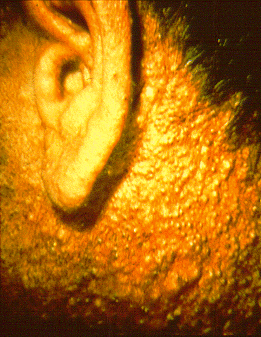Chloracne
Editor-In-Chief: Prab R Tumpati, MD
Obesity, Sleep & Internal medicine
Founder, WikiMD Wellnesspedia &
W8MD medical weight loss NYC and sleep center NYC
| Chloracne | |
|---|---|
| Synonyms | N/A |
| Pronounce | N/A |
| Specialty | N/A |
| Symptoms | Cysts, comedones, pustules, nodules |
| Complications | Scarring, hyperpigmentation |
| Onset | Delayed, typically weeks to months after exposure |
| Duration | Can be long-lasting, sometimes years |
| Types | N/A |
| Causes | Exposure to chlorinated hydrocarbons such as dioxins |
| Risks | Occupational exposure, industrial accidents |
| Diagnosis | Clinical examination, biopsy |
| Differential diagnosis | Acne vulgaris, rosacea, folliculitis |
| Prevention | Avoidance of exposure to causative chemicals |
| Treatment | Topical retinoids, oral retinoids, dermabrasion |
| Medication | N/A |
| Prognosis | Variable, can be persistent |
| Frequency | Rare |
| Deaths | N/A |
Chloracne[edit | edit source]
Chloracne is a rare skin condition that is caused by exposure to certain toxic chemicals, particularly dioxins and polychlorinated biphenyls (PCBs). It is characterized by acne-like eruptions on the skin, primarily affecting the face, neck, and upper body. Chloracne is considered a hallmark of dioxin exposure and is often used as a clinical indicator of such exposure.
Pathophysiology[edit | edit source]
Chloracne results from the toxic effects of certain halogenated aromatic compounds on the skin. These compounds, such as dioxins, interfere with the normal function of the sebaceous glands, leading to the formation of cysts and comedones. The exact mechanism involves the activation of the aryl hydrocarbon receptor (AhR), which alters the expression of genes involved in skin homeostasis and sebaceous gland function.
Clinical Presentation[edit | edit source]
The clinical presentation of chloracne includes the development of blackheads, cysts, and pustules. These lesions are most commonly found on the cheeks, behind the ears, in the armpits, and in the groin area. The severity of chloracne can vary, with some individuals experiencing mild symptoms and others developing severe, disfiguring lesions.
Diagnosis[edit | edit source]
Diagnosis of chloracne is primarily clinical, based on the characteristic appearance of the skin lesions and a history of exposure to potential causative agents. In some cases, a skin biopsy may be performed to confirm the diagnosis. Laboratory tests to measure levels of dioxins or PCBs in the blood or tissues can also support the diagnosis.
Treatment[edit | edit source]
Treatment of chloracne focuses on reducing exposure to the causative agent and managing the skin lesions. Topical and systemic treatments used for acne, such as retinoids and antibiotics, may be employed. In severe cases, surgical intervention may be necessary to remove large cysts or nodules. However, the condition can be persistent and difficult to treat, especially if exposure to the causative agent continues.
Epidemiology[edit | edit source]
Chloracne is a rare condition, primarily affecting individuals who have been exposed to high levels of dioxins or PCBs. Occupational exposure is a common cause, particularly in industries involved in the production or use of these chemicals. Notable cases of chloracne have occurred in industrial accidents and environmental contamination incidents.
Notable Cases[edit | edit source]
One of the most well-known cases of chloracne involved Viktor Yushchenko, the former President of Ukraine, who developed the condition after being poisoned with dioxin in 2004. His case brought significant public attention to the condition and its association with dioxin exposure.
Prevention[edit | edit source]
Preventing chloracne involves minimizing exposure to dioxins and PCBs. This can be achieved through the use of protective equipment in occupational settings, proper handling and disposal of hazardous materials, and adherence to environmental regulations aimed at reducing emissions of these compounds.
See also[edit | edit source]
Search WikiMD
Ad.Tired of being Overweight? Try W8MD's physician weight loss program.
Semaglutide (Ozempic / Wegovy and Tirzepatide (Mounjaro / Zepbound) available.
Advertise on WikiMD
|
WikiMD's Wellness Encyclopedia |
| Let Food Be Thy Medicine Medicine Thy Food - Hippocrates |
Translate this page: - East Asian
中文,
日本,
한국어,
South Asian
हिन्दी,
தமிழ்,
తెలుగు,
Urdu,
ಕನ್ನಡ,
Southeast Asian
Indonesian,
Vietnamese,
Thai,
မြန်မာဘာသာ,
বাংলা
European
español,
Deutsch,
français,
Greek,
português do Brasil,
polski,
română,
русский,
Nederlands,
norsk,
svenska,
suomi,
Italian
Middle Eastern & African
عربى,
Turkish,
Persian,
Hebrew,
Afrikaans,
isiZulu,
Kiswahili,
Other
Bulgarian,
Hungarian,
Czech,
Swedish,
മലയാളം,
मराठी,
ਪੰਜਾਬੀ,
ગુજરાતી,
Portuguese,
Ukrainian
Medical Disclaimer: WikiMD is not a substitute for professional medical advice. The information on WikiMD is provided as an information resource only, may be incorrect, outdated or misleading, and is not to be used or relied on for any diagnostic or treatment purposes. Please consult your health care provider before making any healthcare decisions or for guidance about a specific medical condition. WikiMD expressly disclaims responsibility, and shall have no liability, for any damages, loss, injury, or liability whatsoever suffered as a result of your reliance on the information contained in this site. By visiting this site you agree to the foregoing terms and conditions, which may from time to time be changed or supplemented by WikiMD. If you do not agree to the foregoing terms and conditions, you should not enter or use this site. See full disclaimer.
Credits:Most images are courtesy of Wikimedia commons, and templates, categories Wikipedia, licensed under CC BY SA or similar.
Contributors: Prab R. Tumpati, MD



